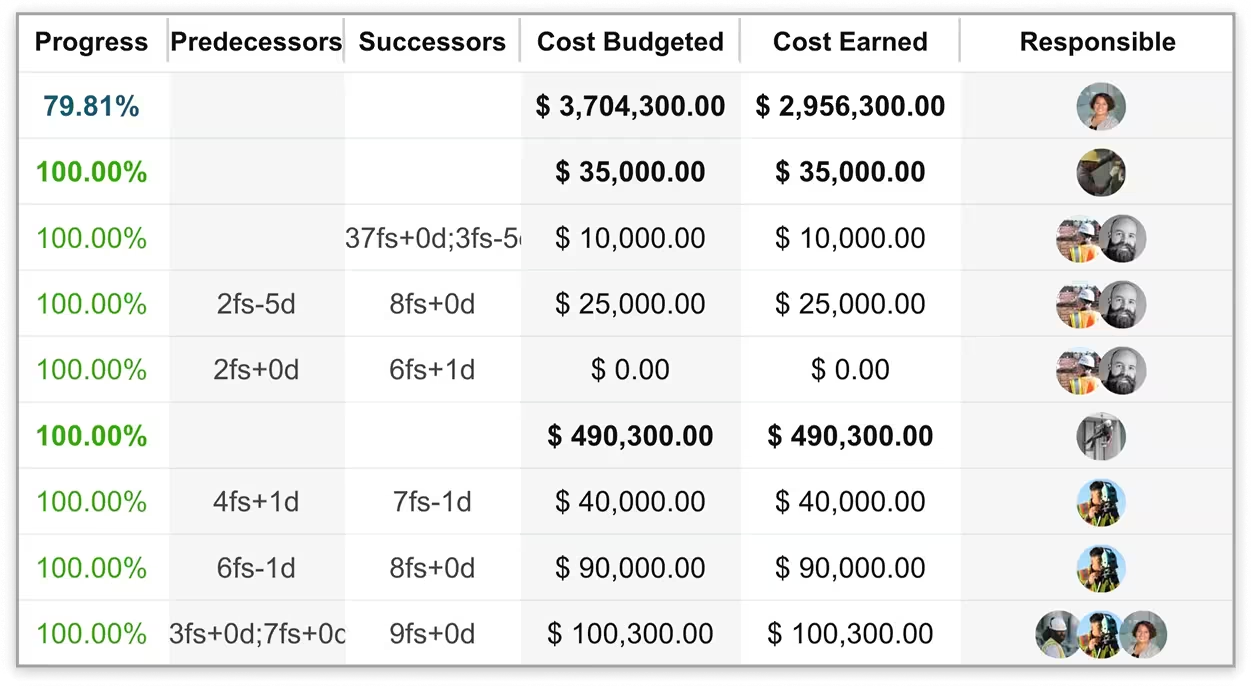Outbuild is online scheduling software to work together on connected project schedules and look-aheads, enabling everyone to move faster.
Key Takeaways
Table of contents
- What is Work in Progress (WIP) in Construction?
- Benefits of Accurate WIP in Construction Accounting
- A Step-by-Step Guide to Calculating WIP
- Work in Progress Examples
- Overcoming WIP Calculation Challenges
- Key Elements of a Construction WIP Report
- Using Construction Software for WIP Management
- Maximizing the Value of Your WIP Reports
- Leverage WIP for Project Success
Managing a construction project isn’t just about laying bricks or pouring concrete. It’s about understanding where you spend your resources and how much work you have completed. This is where the concept of Work in Progress (WIP) comes in.
For construction teams, understanding and monitoring construction WIP is crucial to ensuring project success. This guide will explain what construction WIP is. It will show how to calculate it, its benefits, and how to manage it well in your construction projects.
WIP in construction refers to the total value of work started but not yet completed. It includes all associated costs, such as labor, materials, and overhead items.
Think of it as a snapshot of your project’s progress, showing how much of the budget has been utilized and what remains to be billed. A construction WIP report allows you to track and report these details, aiding in decision-making for timelines, budgeting, and resource allocation.
Obsess over cashflow. The most important tool to measure your cashflow is a work in progress (WIP) report.
— Young Entrepreneur Council, Forbes
Why is WIP Important in Construction?
WIP in Construction provides a clear picture of a project’s financial health. It ensures:
- Accurate revenue recognition based on progress.
- Efficient allocation of resources like materials and labor.
- Transparency with stakeholders about project status.
- The ability to identify delays or over-budget activities early.
Ultimately, proper WIP construction accounting helps project managers maintain profitability and build trust with clients.
Getting work in progress construction accounting right comes with numerous advantages:
1. Improved Cash Flow Management
Accurate WIP construction accounting helps contractors spot cash flow issues early, so they can tackle problems before they get out of hand. For instance, if the work completed doesn’t line up with what’s been billed to the client, it could lead to costly delays or even overdrafts.
2. Enhanced Project Forecasting
By understanding data from a construction work in progress report, contractors can estimate project timelines more precisely. This means fewer surprises and more control over scheduling and supply chain coordination.
3. Better Resource Allocation
Knowing the exact stage of the project ensures the right resources are in the right place at the right time. For instance, if your work in progress construction report shows slow progress, you might need additional workers to get back on track.
4. Increased Stakeholder Confidence
When you share detailed WIP reports with stakeholders, they can see exactly how their money is being utilized. This transparency fosters trust and strengthens client relationships.

Calculating WIP involves determining the value of unfinished work at a specific point in time. Here’s how to simplify the process:
Step 1: Gather Financial Data
Collect all associated costs for the project to date. These costs typically include:
- Direct labor costs (wages of construction workers)
- Material costs (cement, steel, etc.)
- Indirect costs (project overheads like utilities)
Step 2: Determine Percentage of Completion
This is calculated by dividing total costs incurred to date by total estimated costs for the project
Step 3: Multiply Against the Total Budget
Multiply the percentage of completion by the project budget to determine the WIP value. For example, if a project has a budget of $100,000 and the percentage of completion is 50%, the WIP value would be $50,000.
Step 4: Record in Financial Statements
The WIP value should be recorded in the company's financial statements under either work-in-progress or construction in progress. This will accurately reflect the ongoing project costs and help with project management and tracking.

Looking at real-world examples of WIP can help you better understand its role and importance in construction management. These examples show how WIP impacts project finances and decision-making in the construction industry.
Real-World WIP Scenarios
Consider a construction company working on a commercial building project with a total budget of $1 million. By the end of the first quarter, the company had incurred $300,000 in costs. To calculate the WIP, the percentage of completion would be 30% ($300,000 / $1,000,000). This means that $300,000 is recognized as WIP, reflecting the value of the work completed so far.
Sometimes, a contractor might run into delays because of unexpected issues, like bad weather. In this situation, the WIP calculation could show the project is only 20% complete, even though 40% of the budget has already been spent. This kind of discrepancy can lead to rethinking the project’s timeline and how resources are being used.
Understanding WIP Data
Understanding WIP data is key to making smart project management decisions. A high WIP value might mean a lot of work has been completed, but it could also point to cash flow problems if billing hasn’t kept up with progress.
On the flip side, a low WIP value could suggest that the project is running behind schedule or that the team is handling costs well. It's important to understand the story behind the numbers. This helps stakeholders make good financial decisions and maintain client relationships.
While WIP calculations provide essential insights, they are not without hurdles. Below are common challenges and solutions:
1. Tracking Costs in Real-Time
Issue: Delays in recording costs lead to inaccurate WIP reports.
Solution: Use real-time cost-tracking software to ensure all expenses are logged immediately.
2. Misclassifying Costs
Issue: Mixing direct and indirect costs can distort the WIP value.
Solution: Clearly categorize and separate costs before calculations.
3. Estimating Future Costs
Issue: Over- or underestimating total project costs can skew WIP numbers.
Solution: Regularly update cost estimates as the project progresses.
An effective construction WIP report provides an overview of the project’s financial health. Include the following elements:
Project Details:
- Project name and ID
- Project timeline (start date and expected completion date)
Budget Summary:
- Total contract value (original and current)
- Original estimated costs
- Revised estimated costs, if applicable
Costs to Date:
- Direct and indirect costs total
- Total costs incurred to date
Revenue and Billing:
- Amount of revenue received to date
- Total amount billed to date
Percentage of Completion:
- Progress expressed as a percentage
WIP Value:
- The calculated value of completed work
Variance Analysis:
- Discrepancies between actual and estimated costs
- Indication of whether the project is overbilled or underbilled

Manual WIP calculations can be tedious and prone to error. This is where construction accounting software comes in. These tools streamline cost tracking, automate WIP calculations, and generate detailed reports.

Best Software Features
Say goodbye to construction WIP report templates in excel. Look for tools that offer long term success:
- Real-time cost tracking
- Customizable WIP report templates
- Integration with project management tools
- Alerts for budget overruns
WIP reports are more than just accurate financial reporting ; they’re tools to make informed decisions. Here’s how to use them effectively:
- Analyze Trends: Identify recurring issues in delays or cost overruns.
- Share with Stakeholders: Regularly update clients on project status to build trust.
- Plan Strategically: Use historical WIP data to improve forecasts for future projects.
Did you know that Outbuild’s real-time cost tracking helps teams stay proactive in managing budgets and catching cost overruns early?

Mastering work in progress (WIP) in construction is vital for any successful project manager. It gives you the power to control budgets, optimize workflows, and enhance transparency with stakeholders.
By using the right tools, keeping up with reports, and learning from WIP trends, you can keep every project on track and within budget.
Remember, Outbuild simplifies WIP tracking by providing automatic updates to cost-earned metrics. Book a demo or sign up for a free trial today!
While WIP calculations provide essential insights, they are not without hurdles. Below are common challenges and solutions:
1. Tracking Costs in Real-Time
Issue: Delays in recording costs lead to inaccurate WIP reports.
Solution: Use real-time cost-tracking software to ensure all expenses are logged immediately.
2. Misclassifying Costs
Issue: Mixing direct and indirect costs can distort the WIP value.
Solution: Clearly categorize and separate costs before calculations.
3. Estimating Future Costs
Issue: Over- or underestimating total project costs can skew WIP numbers.
Solution: Regularly update cost estimates as the project progresses.
An effective construction WIP report provides an overview of the project’s financial health. Include the following elements:
Project Details:
- Project name and ID
- Project timeline (start date and expected completion date)
Budget Summary:
- Total contract value (original and current)
- Original estimated costs
- Revised estimated costs, if applicable
Costs to Date:
- Direct and indirect costs total
- Total costs incurred to date
Revenue and Billing:
- Amount of revenue received to date
- Total amount billed to date
Percentage of Completion:
- Progress expressed as a percentage
WIP Value:
- The calculated value of completed work
Variance Analysis:
- Discrepancies between actual and estimated costs
- Indication of whether the project is overbilled or underbilled

Manual WIP calculations can be tedious and prone to error. This is where construction accounting software comes in. These tools streamline cost tracking, automate WIP calculations, and generate detailed reports.

Best Software Features
Say goodbye to construction WIP report templates in excel. Look for tools that offer long term success:
- Real-time cost tracking
- Customizable WIP report templates
- Integration with project management tools
- Alerts for budget overruns
WIP reports are more than just accurate financial reporting ; they’re tools to make informed decisions. Here’s how to use them effectively:
- Analyze Trends: Identify recurring issues in delays or cost overruns.
- Share with Stakeholders: Regularly update clients on project status to build trust.
- Plan Strategically: Use historical WIP data to improve forecasts for future projects.
Did you know that Outbuild’s real-time cost tracking helps teams stay proactive in managing budgets and catching cost overruns early?

Mastering work in progress (WIP) in construction is vital for any successful project manager. It gives you the power to control budgets, optimize workflows, and enhance transparency with stakeholders.
By using the right tools, keeping up with reports, and learning from WIP trends, you can keep every project on track and within budget.
Remember, Outbuild simplifies WIP tracking by providing automatic updates to cost-earned metrics. Book a demo or sign up for a free trial today!
Frequently Asked Questions
Related Articles
Ready to see Outbuild?
Join hundreds of contractors from 10+ countries that are saving money by scheduling better







